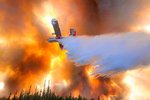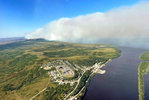

ANCHORAGE, Alaska (AP) — Alaska is burning this year in ways rarely or ever seen, from the largest wildfire in a typically mainly fireproof southwest region to a pair of blazes that ripped through forests and produced smoke that blew hundreds of miles to the Bering Sea community of Nome, where the normally crystal-clear air was pushed into the extremely unhealthy category.
Already more than 530 wildfires have burned an area the size of Connecticut and the usual worst of the fire season lays ahead. While little property has burned, some residents have been forced to evacuate and one person was killed — a helicopter pilot died last month when he crashed while attempting to carry a load of equipment for firefighters.
Recent rains have helped but longer-term forecasts are showing a pattern similar to 2004, when July rains gave way to high-pressure systems, hot days, low humidity, and lightning strikes that fueled Alaska's worst fire year.
In 2004, the acreage burned by mid-July was about the same as now, But by the time that fire season ended, 10,156 square miles were charred.
Heat waves and droughts are making wildfires more frequent, destructive, and harder to fight in many places. This month, wildfires have torn through Portugal, Spain, France, England, and Germany, which have seen record-high temperatures.
California has recorded its largest, most destructive, and deadliest wildfires in the last five years and with the state deep in drought authorities are girding for what may be a late summer and fall filled with smoke and flames.
Alaska, the nation's largest state, also has been dry. Parts saw an early snow melt and then a largely rain-free June that dried out the duff layer — the band of decaying moss and grasses that blankets the floors of boreal forests and the tundra. This organic matter can be up to 2 feet thick but in various stages of decay.
On May 31, a lightning strike on the duff layer in the Yukon–Kuskokwim Delta started the East Fork fire, an area in southwest Alaska that rarely burns. Two communities with a combined population of about 700 were threatened but no mandatory evacuations were ordered in what became the largest wildfire ever in the delta at 259 square miles. Firefighters were able to protect the communities.
In Alaska, a little more than half of all wildfires are started by lightning and the rest are caused by humans accidentally, intentionally, or through negligence. Of the 4,687 square miles burned so far this year, only 2 square miles have been from human-caused fires.
It isn't feasible or necessary to try to fight all Alaskan wildfires. Fire plays a key role in the state's ecology by cleaning out low-lying debris, thinning trees, and renewing habitats for plants and animals, so Alaska typically lets most burn themselves out or wait until rain and snow do the job. Firefighting resources are used to battle fires in populated areas.
So far this year, there’s been about 145,000 lightning strikes in Alaska and adjacent areas of Canada, as counted by the Bureau of Land Management's lightning detection network. A staggering 42% occurred between July 5-11 when weather systems produced rain but about 50 fires also were started.
While there's been little loss of property, smoke from the fires has caused dangerous breathing conditions. In one case, two fires burning near Lake Iliamna joined and in one day burned about 75 square miles (194 square kilometers) of boreal forest, creating smoke and ash that strong winds transported hundreds of miles northwest to Nome, pushing the air quality index into the extremely unhealthy category.